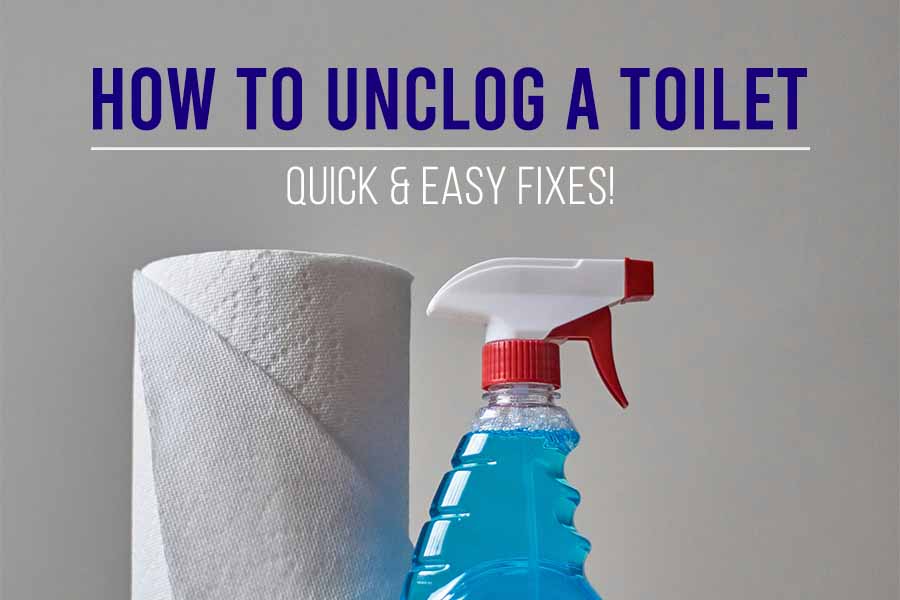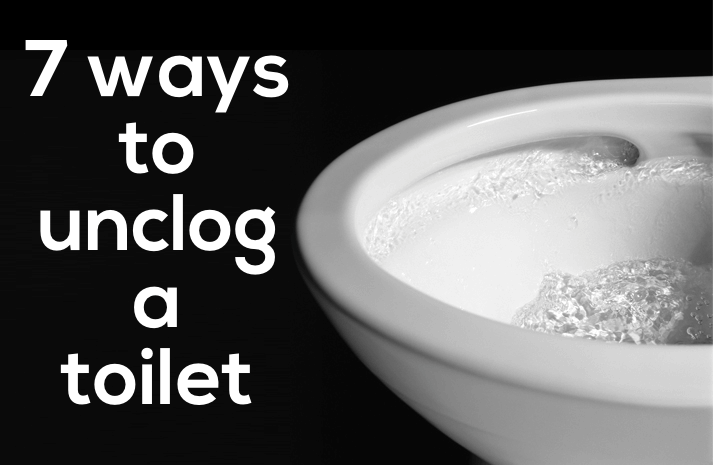
To unclog a toilet, use a plunger to create suction and dislodge the blockage. If unsuccessful, employ a toilet auger to reach deeper into the drain.
Experiencing a clogged toilet can disrupt your daily routine and cause inconvenience. Having the right tools and techniques at your disposal is crucial for a quick resolution. A toilet plunger, with its distinct shape, is designed to seal the bowl inlet and provide the necessary force to clear the blockage.
For more stubborn clogs, a toilet auger, which snakes through the toilet to break up the obstruction, might be necessary. Addressing this common household issue promptly can prevent potential water damage and maintain sanitation. With step-by-step guidance, even those with limited plumbing experience can tackle the challenge of unclogging a toilet and restore functionality to this essential fixture.
Assessing The Situation
Before diving into action, it’s critical to assess your clogged toilet scenario. Understanding the type and seriousness of the clog will determine the best approach to take. A methodical assessment can prevent messes and ensure a swift resolution to the problem.
Identify The Type Of Clog
The first step in tackling a clogged toilet is to identify what you’re dealing with. Soft clogs are typically caused by organic material like toilet paper and can often be resolved with a plunger. Hard clogs, on the other hand, may involve foreign objects that aren’t meant to be flushed and might need more advanced tools or professional help. Consider these indicators for an accurate diagnosis:
- Water level remains high after flushing – possible soft clog.
- Water overflows or drains very slowly – potential hard clog.
- Odd noises from the plumbing – could suggest a deeper blockage.
Gather Necessary Tools
Once you’ve determined the clog type, gather the tools needed for the unclogging process. Start with the basics and consider additional items if the clog is stubborn. Here’s a list of tools to have on hand:
| Tool | Use |
|---|---|
| Plunger | Dislodging soft clogs |
| Auger (Snake) | Breaking up hard or deep clogs |
| Bucket | Bailing out water if needed |
| Rubber Gloves | Sanitation and grip |
| Hot Water | Loosening minor clogs |
| Dish Soap | Helping to break down waste |
Equip yourself with the tools above and prepare to tackle your clogged toilet with confidence.
:max_bytes(150000):strip_icc()/unclogging-a-toilet-with-a-plunger-2719030_final_horizontal_10_18-d33deec2a8084e289a5427c6745a0d32.png)
Credit: www.thespruce.com
Initial Attempts To Unclog
Facing a clogged toilet challenge can certainly throw a wrench in your day. No need to despair! Before reaching out to a plumber, there are a few tried-and-true methods you can attempt to clear the way without professional help. These initial strategies are often effective and can save you both time and money.
Use A Plunger Effectively
To tackle a clog with a plunger, make sure you have the right tool. A flange plunger is ideal for toilets. Here’s how to use it:
- Fit the plunger over the toilet’s drain hole.
- Pump the plunger up and down vigorously.
- Maintain a firm seal for suction.
- Repeat until the water drains, indicating a clear passage.
Hot Water And Dish Soap Method
Hot water and dish soap can often break up a clog. Here’s a simple guide:
- Pour a bucket of hot water from waist height into the toilet bowl.
- Add a few squirts of liquid dish soap.
- Allow the mixture to sit for 20 minutes.
- Try flushing. The soap acts as a lubricant to help release the clog.
Diy Solutions For Stubborn Clogs
Stubborn toilet clogs can be a real hassle. No one enjoys the panic that sets in when the water rises to the brim. Traditional plunging might not always work. Before you call a plumber, try these simple yet effective DIY solutions. You might just clear that stubborn clog with items from around your home.
Baking Soda & Vinegar Mix
A classic science fair experiment comes to the rescue. Baking soda and vinegar can break down clogs without a plunger. Follow these steps:
- Pour 1 cup of baking soda into the toilet.
- Slowly add 2 cups of vinegar. Watch for fizzing.
- Wait 30 minutes. The mix breaks down the clog.
- Flush carefully. The clog should clear.
Wire Coat Hanger Technique
Sometimes a plunger isn’t enough. Use a wire hanger for tough clogs. Follow these steps:
- Unwind the hanger. Keep the hook.
- Wrap the end with a rag. Secure it with tape.
- Gently push into the drain. Hook the clog.
- Pull out the obstruction. Flush to check flow.

Credit: bfplumbingbayarea.com
Commercial Products For Tough Blockages
Confronting a stubborn toilet blockage can be a daunting task. Before reaching out for the plunger, various commercial products can offer a simple solution. These products come in many forms. They range from chemical solutions to eco-friendly enzymatic formulas. It’s essential to know the right tool for the job. This will not only clear the blockage effectively but also protect plumbing and the environment.
Chemical Drain Cleaners: Pros And Cons
Chemical drain cleaners are popular for their power to dissolve serious obstructions. These products are readily available and act fast to break down the gunk.
- Pros:
- Fast-acting
- Easy to use
- Effective on various blockages
- Cons:
- Can be harmful to pipes with frequent use
- Potentially dangerous chemicals
- Not environmentally friendly
Enzymatic Cleaners: An Eco-friendly Option
Enzymatic cleaners provide a greener solution for unclogging toilets. These cleaners use natural enzymes and bacteria to break down organic waste.
- Pros:
- Safer for pipes and septic systems
- Environmentally friendly
- Non-toxic to humans and pets
- Cons:
- Slower action compared to chemicals
- May require repeated applications
- Less effective on non-organic blockages
Choose the right commercial product based on the blockage severity and the priority of eco-friendliness. Always follow instructions carefully and use precautions when handling any cleaning chemicals. For an eco-friendly option, give enzymatic cleaners a try and see the benefits to both your pipes and the planet.
Prevention And Maintenance
An ounce of prevention is worth a pound of cure, especially when it comes to maintaining your toilet. To avoid the headache of a clogged toilet, adopt a proactive approach with preventative measures. Proactive steps can save you time, money, and the unpleasantness of handling a toilet clog.
Regular Cleaning Rituals
Keeping your toilet clean not only ensures a pleasant bathroom experience but also helps prevent clogs. Here’s a simple cleaning routine:
- Weekly Scrub: Use a toilet brush and a mild cleaner to scrub the bowl.
- Flush Rinse: A quick flush post-scrub removes any remaining debris.
- Monthly Check: Inspect the flushing mechanism and water passages for issues.
What Not To Flush: Keeping Toilets Clear
Many clogs happen because of items that shouldn’t be flushed. Protect your plumbing with these guidelines:
| Do Flush | Do Not Flush |
|---|---|
| Human waste | Wipes, even if labeled ‘flushable’ |
| Toilet paper | Feminine hygiene products |
| Paper towels | |
| Cotton swabs | |
| Dental floss | |
| Hair |

Credit: www.youtube.com
When To Call A Professional
Unclogging a toilet can seem straightforward. Yet, certain situations require professional help. Recognizing when to call a plumber is crucial. This way, you avoid costly damages and ensure the job gets done correctly.
Signs You Need Expert Help
Sometimes a plunger just isn’t enough. Look for these key signs:
- Water rising instead of draining
- Strange gurgling sounds from fixtures
- Waste water backing up in sinks
- Repeated clogs despite efforts
- Presence of sewage smells
Choosing The Right Plumber
Select a qualified professional with these steps:
- Verify licensing and insurance
- Read customer reviews
- Ask for a clear cost estimate
- Ensure they offer a service guarantee
Frequently Asked Questions On How To Unclog A Toilet
Can Boiling Water Unclog A Toilet?
Boiling water can sometimes help to dissolve organic matter clogging a toilet. However, pour it slowly and carefully to avoid thermal shock to the porcelain, which can cause damage. It’s best combined with dish soap for improved effectiveness.
What Causes Toilets To Clog Frequently?
Frequent clogs often result from flushing too much toilet paper, non-flushable items like wipes, or an underlying plumbing issue. A blocked vent pipe or a larger obstruction deeper in the plumbing could also be responsible.
Will Vinegar And Baking Soda Clear A Toilet?
Yes, vinegar and baking soda can create a natural chemical reaction that may clear minor clogs. Pour one cup of baking soda followed by one to two cups of vinegar into the toilet, let it fizz for a few minutes, then flush.
How Do You Unclog A Toilet Without A Plunger?
Without a plunger, you can use hot water mixed with dish soap, a toilet brush, or a homemade wire hanger snake to dislodge the blockage. Chemical drain cleaners are another option, but use them as a last resort due to potential pipe harm.
Conclusion
Tackling a clogged toilet no longer needs to be daunting. With these simple techniques, your bathroom issues can be resolved swiftly. Remember, regular maintenance is key to preventing future blockages. For stubborn clogs, don’t hesitate to call a professional. Keep your toilet flush with success by following these easy steps!




















